Signal Detection Theory Psychology Pdf
Today we are going to talk about Signal Detection Theory Psychology Pdf, as in the last lectures we have been talking about sensation and perception we have been talking about how to measure sensation in one of the earlier lectures I told you about classical psychophysics and how it has been used to measure elements of sensation we have talked about quite a few methods most of which come under classical psychophysical theory in order to determine concepts like absolute threshold different threshold etcetera.
In the last lecture, we talked about threshold determination. What if, we don’t need to determine a threshold, and our sensory experiences primarily work on evidence and decision processes? Signal Detection Theory (SDT) is all about that. It takes into account both the sensitivity of the observer, the evidence provided by the stimulus, and the decision processes. It offers something that the classical psycho-physical methods don’t, in that it helps us to understand the decision-making process of experiencing and reporting sensations.
We have seen that these processes basically help us identify when a person is feeling a particular sensation and how that sensation can be quantified using some of the methods like the method of adjustment or the method of constant stimuli etcetera today I will be talking to you about a particular theory which kind of diverges in its approach towards measuring sensation this particular theory is called signal detection theory.
We will see some of the merits and maybe how this theory is slightly different from other class classical psychophysical methods now we have been talking about the importance of thresholds isn’t it how would it be if say for example we do not need to determine threshold in the first place can we do with something else can we do with a related concept which does not really merely depend on determining at what point somebody perceives a particular physical stimulus according to the theory of signal detection our perception, in general, is controlled by evidence and decision processes so any stimulus in the environment can be treated of as evidence.
For example, a particular ray of light falling on the retina is evidence of light that is there in the external environment and you have to take a decision whether the light is let us say bright enough or not or whether the light is whether there is any light at all in the first place.
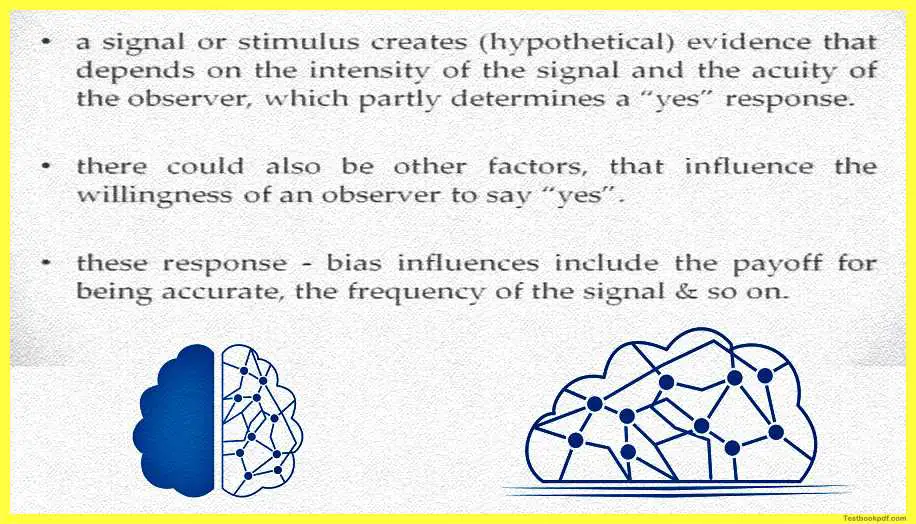
So signal detection theory basically assumes these processes as a sum of both evidence which is the property of the stimulus and decision processes that are the property of the perceiver a signal or a stimulus creates evidence that depends on the intensity of the signal and also the equity of the observer say for example I ask you to distinguish between two shapes partly this depends upon how different the two shapes are from each other if it’s a small line it’s a very large line next to it also it depends on your ability to see the difference between the two stimuli so that is equity of your equity of the perceiver or the observer both of these factors interact to determine whether you will give a yes response to the question that things are different or whether you have detected something there could also be other.
Factors that determine how you are going to respond to that question say for example the willingness of an observer to say yes maybe if you are not very sure maybe if the decision is slightly valuable to make maybe you not say yes maybe you will wait for a completely more completely convincing case and more evidence to say yes these kinds of influences which determine whether you want to say yes or not or your willingness to say yes or not are called response biases these response bias influences.
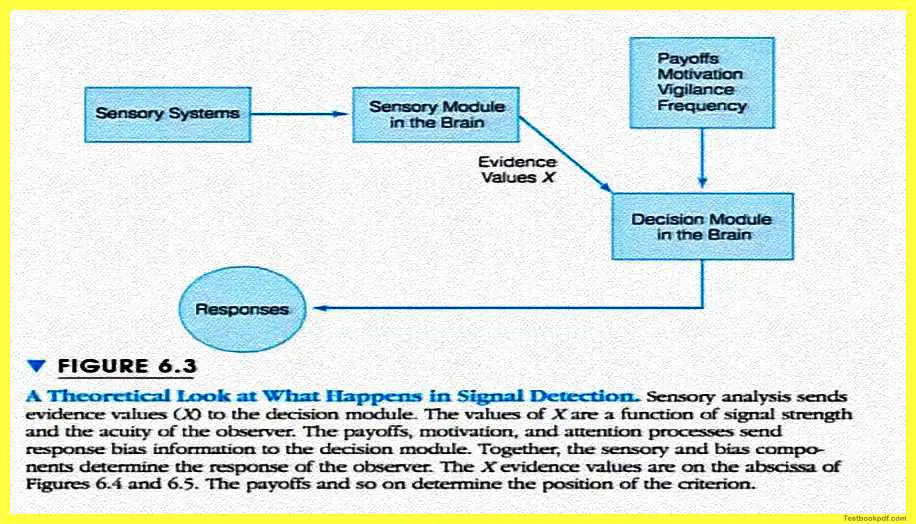
Also include the payoff for being accurate or the frequency of the signal and so many other factors we will talk about them as we move ahead.
Look at this figure here you will see this is basically how a theoretical representation of what signal detection really means you can see that there are sensory systems here there is a particular sensory module in the brain and the sensory module in the brain evaluates the evidence values which is basically the intensity of the stimulus and those kinds of things then you will see that these evidence values feed on to a particular box which is the decision module the brain has to decide.
Whether to say different or not different or whether to say detected or not detected and in there you will see a modulating factor is the payoffs or the motivation or vigilance how alert you were if that when that signal was presented what is the frequency of that signal does it happen once in hundred times or does it happen let us say 60 times 100 times this decision-making module of the brain actually leads on to the kind of responses that you will end up giving?
So this in a nutshell is how a signal detection theory really approaches this whole aspect of people detecting particular pers particular sensations to let us take an example of the fact of the willingness thing say for example imagine if your friend has set up a blind date for you.
Now you have to really tell him within one hour or so whether you are interested in going on that date or not now you are thinking now what could be the cost of such a decision the maximum cost for saying no to a blind date or saying yes to a blind date in that sense could be let us say you will waste an evening you do not like the person you were set up with you did not like their behavior and stuff so maximum what will happen you’ll waste an evening maybe you will say.
Not Even like the Food
For example, not even like the food these costs are slightly lesser isn’t it and the possible benefits could be much higher say for example if you like the person if the two of you strike a chord and an exciting evening happens and many more happen in the future so this kind of is a cost versus benefit analysis of this decision in such scenarios when the costs are slightly lesser as compared to possible benefits people basically highly favor a yes strategy.
So what they will do is that they will kind of evaluate what are the cost what are the benefits if they find that the benefits are slightly more than the cost they will actually go on with the yes response more often than not this decision basically if you see now is based on the analysis of costs and benefit because you do not really have any information about the stimulus you do not know about the girl it is a blind date you do not know what else to take into account that is one way of doing it.
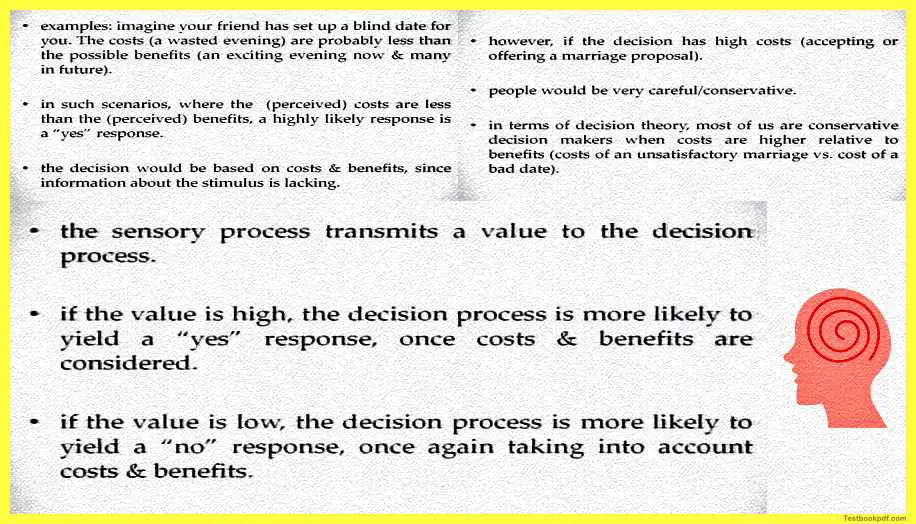
However, if you have a high-cost decision to make say for example if you have to say yes or no to a marriage proposal that maybe one of your parents has brought to you now you still if you do not know any information about the girl you do not know what is what does she look like what is her education other things that you might want to consider how do you do it then people have been found to be very careful and very conservative in scenarios where the possible benefits or where the incurred costs are much more than the possible benefits in terms of the decision.
Theory most of us there in these kinds of scenarios are very conservative decision-makers when costs are higher relative to the benefits.
Now leaving aside this kind of process let us talk about the sensory processes here the sensory process basically transmits a particular value to the decision-making modules of the decision processes if this value is considerably high the decision is more likely to yield a yes response because you have enough evidence to say yes about any decision about the fact that there is light in the room about the fact that there is a particular kind of temperature in the room those kinds of things obviously.
You evaluate the costs and benefits of this value given by the sensory processes to the decision-making process is low the evidence is less than basically what will happen is that you are more likely to yield a no response once again take after taking into account the cost and the benefits.
Now, what determines the quality of the signal what determines what kind of signal that is coming in signal detection theory has two assumptions first is that it assumes that there is always noise present there is always a disturbance that can be confused with signals and is always present whenever a human being attempted to detect any kind of signal and these this the source of this noise could be anything it could be environmental changes it could be equipment changes maybe you are measuring temperature.
For example, using different kinds of thermometers there will be some degree of error there is this concept of zero error in the physical measurement instruments it could be spontaneous neural activity because here the measurement is not actually an external device the measurement is you yourself maybe you are not attentive enough at that point in time maybe you are just slightly tired and so somebody is speaking and you cannot really attend to it very attentively say ok.
So in that sense, it is very possible that somebody is telling you something and you kind of you just mind your mind wandered somewhere and you missed the details of what was said a lot of time that might happen when somebody is giving out a shopping list you kind of slightly not concentrating and some of the important ingredients are left out and at least that might lead to problems there could be other sources of these kinds of noise as well say.
For example, different kinds of experimental manipulations can be done with the receiver let us look at one of these kinds of experimental manipulation imagine if you are sitting in a soundproof booth wearing headphones it’s a soundproof booth you have just given headphones and you’ve been asked to decide whether you’ve heard a faint tone combined with white noise or you only heard white noise maybe it could be just a machine-generated tone like something like that and it is mixed with white noise which is again system generated noise does not have a lot of meaning a trial might begin by presentation of a flashlight that is to gain your attention to get you ready then what you hear is a burst of white noise which now may or may not contain the faint tone signal now you have to decide whether this white noise contains that signal or not you would say yes if you think a tone signal was present you would say no if you think it was not.
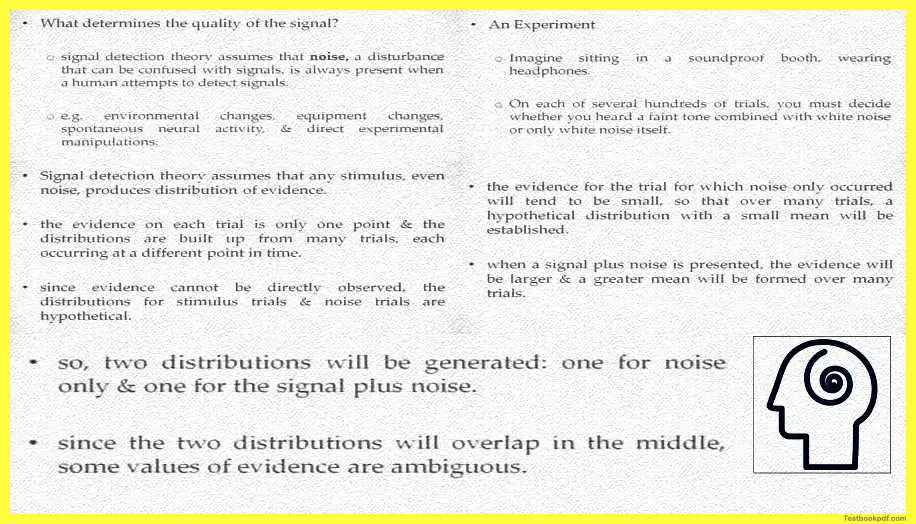
Now signal detection theory in these kinds of scenarios assumes that any stimulus even noise produces what is called a distribution of evidence there will be different points so the evidence on each trial will be just one point but you will actually go through many such trials so there will be a distribution of all of these points so basically what will happen is say for example also since evidence cannot be directly observed the distribution for stimulus trials and noise trials are both they will be hypothetical.
What you might have is that the evidence for a trial for which only noise occurred will tend to be small there will be less evidence there so that over many trials a hypothetical distribution with a very small mean will be served if you are trying to just draw a distribution of the noise trials very few trials had noise so very small mean and a very small distribution will be there if you think of trials where noise and signal that is the faint tone were both presented you will basically have a larger distribution with a greater mean again formed over many trials still talking about that experiment now.
So you will have two distributions one will be the noise distribution the other will be the signal plus noise distribution since these two distributions will anyways overlap somewhere in the middle some values of evidence will be slightly ambiguous those are values where you are not really sure about where whether there was noise or whether there was only noise or whether there was signal in the noise as well here is what this distribution might look like.

So, you have a noise distribution you have a signal plus noise distribution and you have a distance between the means of these two distributions this distance basically is called d prime which is basically your sensitivity we will talk about this very shortly.
How do you decide whether there was noise present or not?
You need to set some criterion that beyond this point I will say that yes the signal was present before this point I will say no the signal is not present so a criterion must therefore be set to determine whether you will give a yes response or a no response the position for this criterion is basically set up by what is called the decision process if the constant benefits analysis kind of says favors a liberal decision policy things like going on.
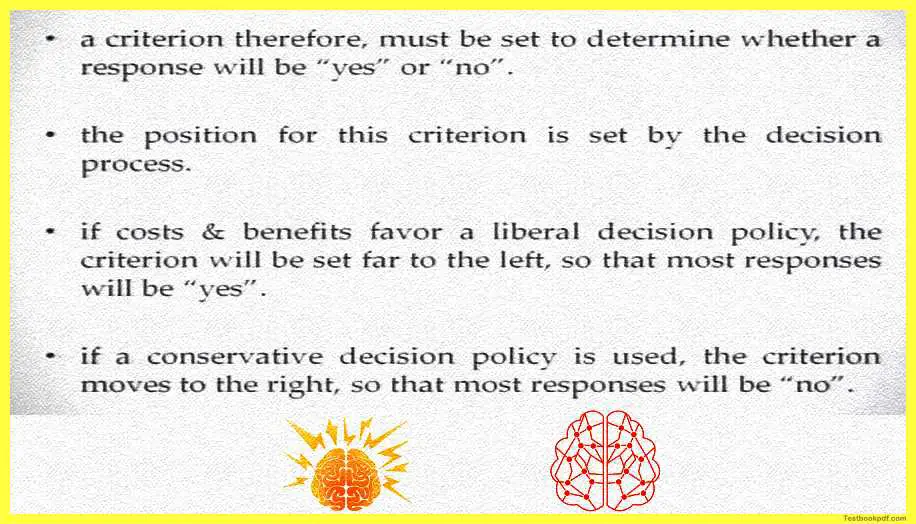
A Blind Date
A blind date with somebody the criterion will be set slightly further to the left so that most of the responses will yield in yes response most of the trials will yield a yes response if it is a conservative decision policy something very important to the criterion will move slightly towards the right and what you will do is you will say more no responses it basically depends on the value of the decision.
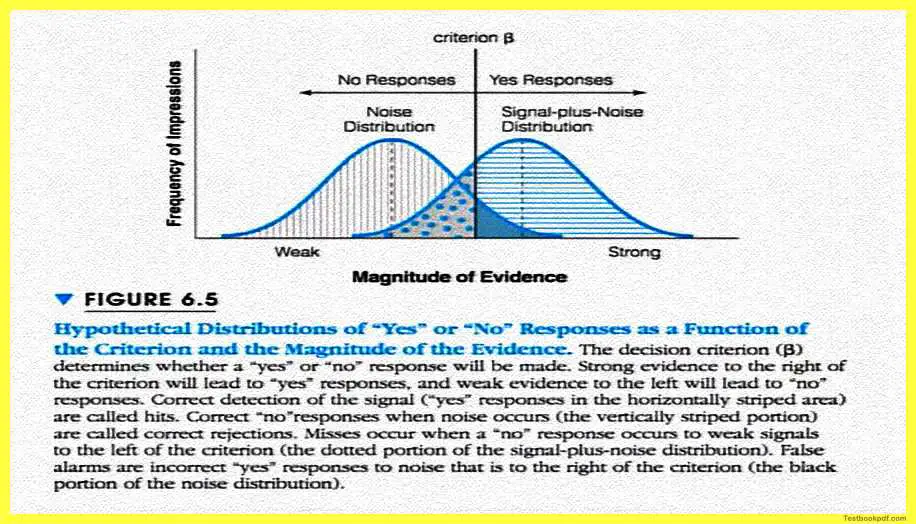
So, here is how you really plot the criterion you can move the criterion slightly to the right to yield more no responses and slightly to the left to yield more yes responses this is this decision Criteria is called beta so it determines basically whether you will make a yes response or whether you will make a no response so if that is clear we can slightly move further we can understand that anyways anyhow this distribution turns up there will be some errors of judgment there will be some values where you will not really be clear if you detected the correct signal, for example, this will be called a hit if say for example if incorrectly.
Responded yes where there was no signal then that scenario will be called a scenario of false alarm so if you are following a very liberal decision-making study you are saying yes to everything then what you what will happen is you will have a lot of hits, yes but you will have a lot of false alarms as well because your tendency is to say yes to most responses on the other hand if you follow a conservative decision strategy then there will be a low number of hits and there will also be a low number of false alarms.

So, you will probably have very few false alarms but you will have a lot of misses as well because you did not say yes when the signal was there because you are following you want to be really very very sure of the presence of the signal now if you plot this if you plot a function of hits as a function of false alarms and as the criteria move from conservative to liberal we get a particular figure this figure is basically known as the receiver operating characteristic or the roc curve in this figure you can see and I will show you in a moment that both hits and false alarms are infrequent are actually infrequent.
At the lower left of the curve, you can see the figure here the lower left side of the curve but both hits and false alarms become more and more frequent if you move towards the upper right side of this particular curve so this is basically something which tells you about the decision making process as well that whether you following a conservative process or a liberal process the slope of this particular function will tell you two things if there is a flat slope it will tell you that you have been following a liberal decision-making criterion if the slope is slightly steeper you will it will reveal a conservative criterion that you have been having very few hits but very few false alarms as well the slope of this curve basically such as the roc function is determined by a slope of the line that is drawn as a tangent to this curve and it will interact either of the axes.
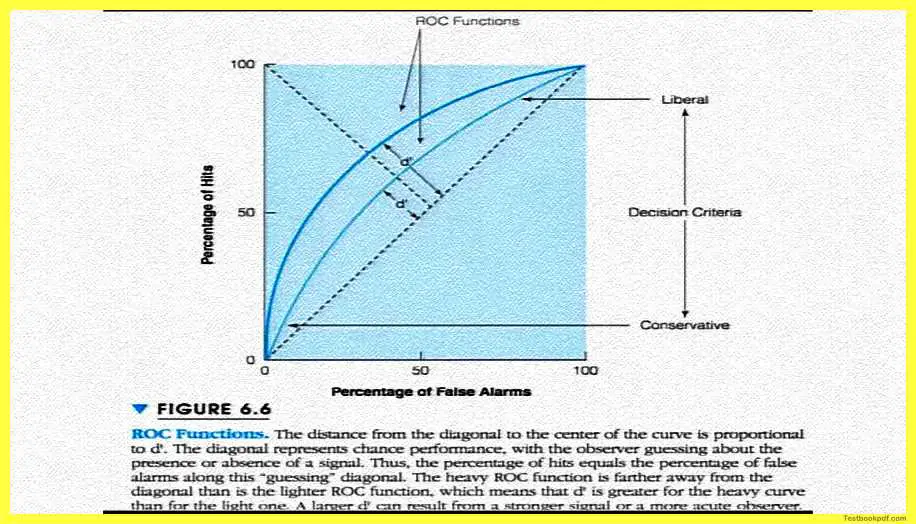
It might interdict the x-axis or the y-axis if the curve is too steep it will probably intersect with the y-axis x-axis if it is slightly flattering it will kind of intersect the y-axis now the distance if you see this figure again the distance from the diagonal to this curve.
Tells us how far apart the noise and the signal plus noise distributions are when these two distributions are far apart from the Indica and indicating either a more discernible signal or more acute observer so there could be two things isn’t it either the signal is very clear so that you can detect it all the time either you very good at detecting that signal so whether it indicates a very discernible signal or whether it indicates a very acute observer the roc curve moves upward to the left.
Okay and away from the diagonal as shown by the heavy roc function you can see this one here you can see one of these figures is slightly higher dotted it’s a slightly heavier line than the one at the top when the signal is less detectable or say for example the observer is not very good at detecting that and the distribution the distributions will be slightly closer together so the roc curve will move slightly closer to the diagonal so you can see here.
That this will be slightly closer to the diagonal which is the lighter roc function which you see here so the d prime basically is much smaller than the d prime in the earlier part so the roc function basically tells us about both it tells us about the sensory processes that are the distance between the signal plus noise and the noise and basically on the noise distributions it also tells us the criteria which you have been following it also tells us about the decision-making process which is beta.
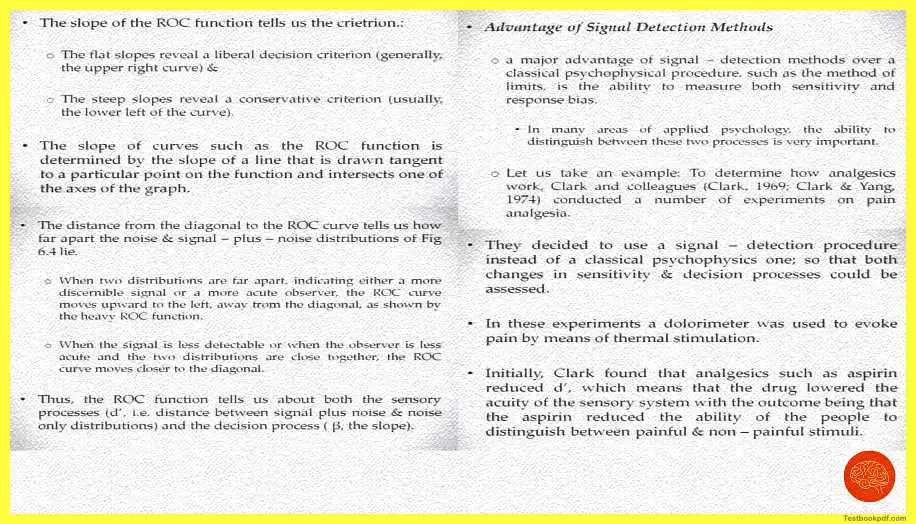
Ok now, what does this signal detection method or what does this theory really have in for us one of the major advantages of the signal detection methods over classical psychophysics psychophysical procedures like we had in the last lecture such as for example the method of limits is that there is this ability to measure and quantify both the sensitivity of the observer and the response fast both can really be plotted and figured out here I have not gone into great detail about those calculations because again you just doing this at an introductory level you’re not really going into much more detail but those of you interested can actually look into them and maybe ask questions but this ability of really talking about and quantifying?
Both sensitivity and response bias is really important in many areas of applied psychology say for the exam this ability to distinguish between these two processes is very important I can take an example of say for example if there is and if there’s a soldier at uh at the border and he’s basically reading uh taking readings from the radar whether a particular enemy is approaching or whether anime is not approaching basically is a costly decision.
If the enemy is approaching and you miss it you kind of are putting everybody else in danger if it’s not the enemy and you shoot down somebody by mistake you’re still committing a grave crime so that kind of decision is slightly expensive to make or say for example if you are a doctor and somebody comes and shows you their x-ray report and you have to detect whether there is a cancerous tumor present or not it can again be a very costly decision.
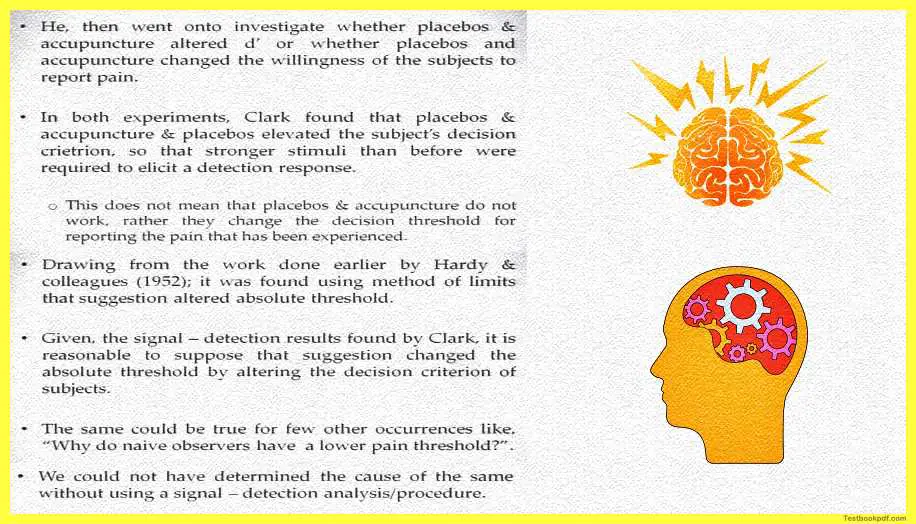
If you go by a very conservative strategy and say yes there is a tumor and there is a poor patient who has come you are throwing him to a particular result of buying very expensive medicines etcetera, etcetera which are not needed in the first place or if you actually follow a very conservative strategy and you say no there is no tumor you find and the person kind of and that ends up dying because the tumor was not diagnosed in time then also you are committing a very grave mistake.
So, in those kinds of scenarios signal detection kind of methods are really very important and they are have they have been extensively used as well i will take an example to elaborate on this here say for example to determine how analgesics work Clark and colleagues they conducted a number of experiments on pain analgesia they wanted to test whether how and how basically these analgesics like aspirin, etc work.
So they basically decided to use signal detection procedure instead of the classical psychophysics methods and what they do as basically in these experiments they used something called a Dolorimeter to evoke pain by means of thermal stimulation so it was an instrument that was applied in the skin it kind of delivered heat in some sense and that could either lead to pain or less pain or more pain something like that initially Clark found that analgesics such as aspirin reduce the d prime they reduce the sensitivity of the observer which means the drug basically is really reducing or lowering down the equity of the sensory system with the outcome being that the as the ability of the observer to distinguish between painful and non-painful stimulus is lowered down it might this kind of thing might have its own benefits but then they went on to investigate whether placebos or acupuncture etc.
Alter d prime or whether placebos or acupuncture change the willingness of the participant to report pay in both these experiments Clark found that placebo is acupuncture, acupuncture basically elevated the subjects decision criterion so a stronger stimulation was needed for the subject to say yes or for the subject to re-report pain detection response now this actually does not mean that placebos and acupuncture etcetera will not work but what they are doing is they are working with a slightly different method they are basically changing the decision threshold they are not changing the sensitivity of the observer the sensitivity is still there but the decision threshold is actually changed also drawing from earlier work done by hardy and colleagues 1952.
It was found that using meth it was found using methods of limits that suggestions if you tell somebody that you are not feeling pain or stuff like that also alters absolute threshold so given the kind of work we saw just now a signal detection method used by Clark and colleagues it is reasonable to suppose that suggestion basically what it did was it changed the absolute threshold by altering the decision criterion of subjects so it you are basically suggesting to the person that no you are not feeling pain no you are not feeling pain until the pain becomes unbearable for the participant to actually report pain so the same could be true for other kinds of occurrences as well say for example if you have a knife observer somebody is not been part of this experiment and you kind of start this experiment with this kind of participant you will see that the knife observers will have a very lower threshold immediately saying yes i felt fain i felt pain something like that now this basically this kind of things could not have been determined using classical psychophysical methods.
You know about decision criterion etc using classical psychophysical methods and this in itself is a major advantage a major major advantage of signal detection kind of methods so coming to the close trying, to sum up, we found out that signal detection measures are a departure from the classical psychophysical methods as they take into account both the sensitivity of the observer and the evidence provided by the stimulus and also the decision making processes.
So, it kind of takes care of all of these three things and they are better because they help us understand the decision-making process of the participant experiencing and reporting these sensations so this is basically the end of the series about psychophysics in the next class onwards will start talking about issues related to perception thank you for reading this article.
Read also:
Sensation and Perception Psychology Pdf
Psychophysics Measuring Sensation (Pdf)
Click here for Complete Psychology Teaching Study Material in Hindi – Lets Learn Squad



